Profit potential…
By the end of the 2010s, the not-so-coincidentally-combined mega-division of Disney Parks, Experiences, and Consumer Products under then-Chairman Bob Chapek began to evolve. In his exceptional interview with Dan Heaton’s “Tomorrow Society” podcast, Len Testa of Touring Plans contends that after decades of using “guest satisfaction” as a key performance indicator, Disney Parks in late 2010s not-so-subtly shifted to “per capita” – that is, spending per-guest – as the division’s defining data point.
In the age of add-ons, Disney Parks executives might’ve regretted having a priority service like FastPass “baked in” to trip planning for free, and equally available to on-and-offsite guests. Surely, ripping two decades of free FastPass access out from under guests would be a public relations nightmare… but upgrading it? It was worth testing.

At Disneyland in California – where FastPass+ had been deemed too involved for the heavily-local audience, and where “old-fashioned” paper FastPass still reigned – 2017 saw the launch of MaxPass, an optional upgrade for $10 (later, $15) per person, per day. Instead of requiring guests to collect paper FastPasses from distribution kiosks outside of attractions, MaxPass merely allowed guests to secure return time windows through the Disneyland app… still day-of, still one-at-a-time, and still with rolling reservations throughout the day.
Adding tremendous convenience (by negating the need for a “FastPass runner” to physically collect return time tickets through the day), adding the service for $45 on top of a 3-day ticket was, frankly, a no-brainer. MaxPass was a true “add-on” service given how it let guests book their next attraction from anywhere – including queues, restaurants, and even from the hotel pool – keeping the day “flowing” beautifully with app-based convenience.
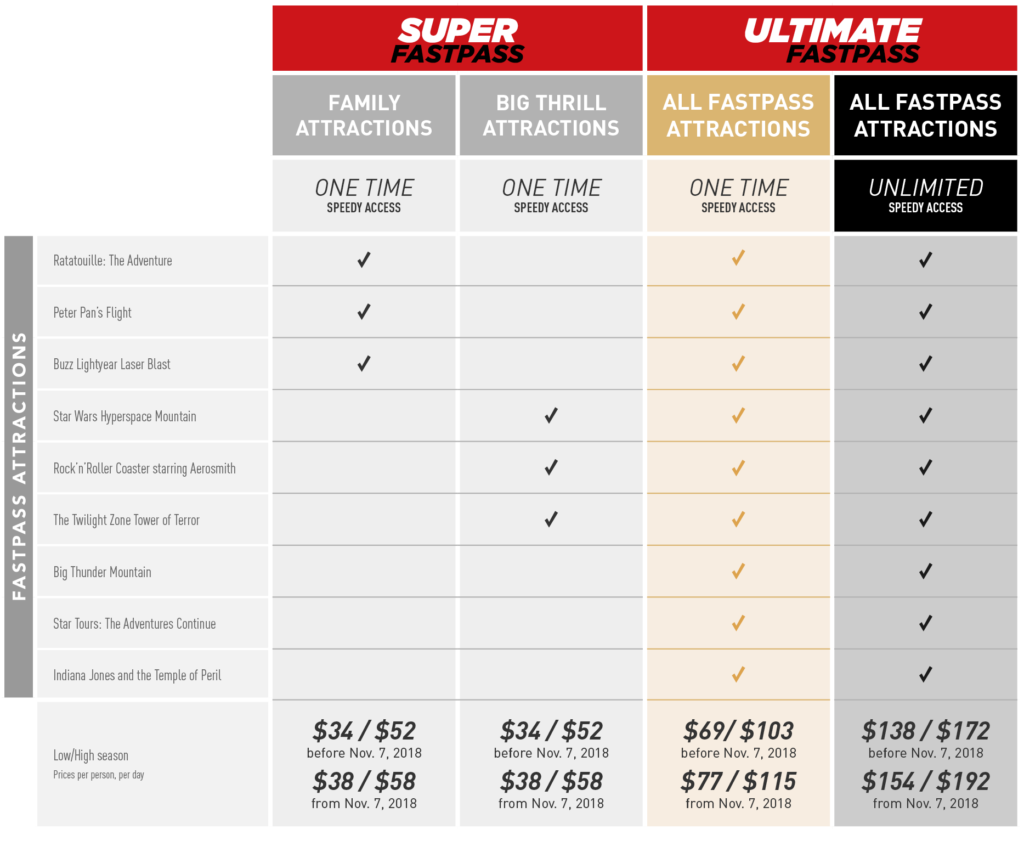
Disneyland Paris kept its legacy paper FastPass, too, but experimented with its own optional add-on: bundling anytime access to FastPass queues a la Universal’s Express pass. In addition to access to the standard FastPass system, guests could purchase either the “Family Attractions” or “Big Thrill Attractions” SUPER FastPass package, each granting one-time, anytime FastPass access to three rides for $34 to $58 flat. The ULTIMATE FastPass package (combining the “Family” and “Big Thrill” packages, plus three rides exclusive to the premium package) ranged from $69 to $115 for one-time-per-ride access, or $138 to $192 for unlimited.
Predictably low-tech for the French resort, Super and Ultimate FastPasses were merely tickets with each attraction printed on the back, with Cast Members crossing each out with permanent marker as it was used. Still, for the first-time traveler to Disneyland Paris or the once-in-a-lifetime vacation, even the higher prices of Paris’ system added a sense of relief to the day, knowing you’d get at least one ride on every major attraction without waiting.
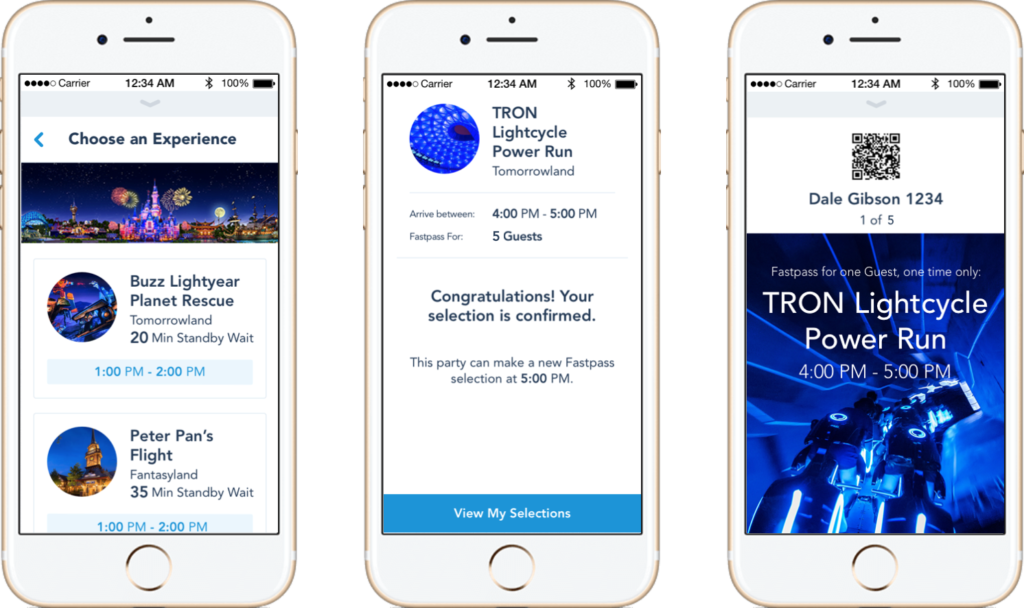
At Shanghai Disneyland, Premier Access was allegedly designed to combat scalpers reselling one-off paper FastPasses by instead allowing Disney to sell one-off FastPasses. (You can take the park out of rugged capitalism, but you can’t take the rugged capitalism out of the park.) Shanghai’s Premier Access allowed MaxPass-style rolling reservation booking and Paris-style bundles, plus the concept of one-off, a la carte immediate access.
Curiously, aside from the option for Disney World’s Club Level guests to purchase three additional FastPass+ reservations for $50, Disney World’s system stayed surprisingly stable and surprisingly equitable, with no upcharge options or even quantifiable benefits for on-site guests aside from a booking head-start. Surely, the ability to generate revenue from line-skipping must’ve been an interest of Team Disney Orlando… but what could ever happen that would allow Disney to fundamentally reinvent a ubiquitous, beloved, and famously-free service?
2020

It goes without saying for most readers that in March 2020, Walt Disney World – and the world as a whole – was changed forever. Increasing and largely unmitigated spread of the then-unknown COVID-19 virus ignited global response. A nationwide push to “slow the spread” and “flatten the curve” of the deadly respiratory virus’s infection rate lead to stay-at-home recommendations, federal stimulus payments, unprecedented unemployment, and an international pause on “non-essential” businesses.
In retrospect, the March 12, 2020 announcement that Walt Disney World’s theme parks would remain closed “through the end of the month” sounds downright naive. Even in the regulatorily-loose state of Florida (where a conservative-led culture war against disease prevention measures, public health orders, and mass vaccination still rages years later), Walt Disney World was closed for 116 days, re-opening on July 11, 2020. (Disneyland’s much more cautious and restrictive state of California saw the West Coast resort closed for 412 days… well over a year).
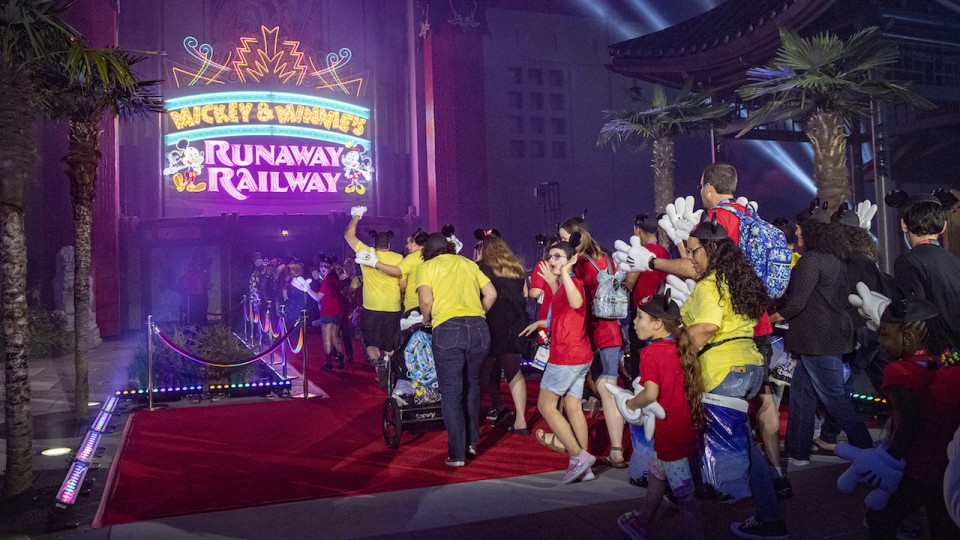
When Walt Disney World re-opened, it was with some major and (in line with continued understanding about the virus) malleable operational changes, like temperature screenings, face coverings, plexiglass barriers, and attraction closures. Even with vastly restricted capacity controlled by a new “Park Pass” reservation system, the need for six-foot “social distancing” between parties saw even short-wait queues spill out into backstage areas and park paths.
Into this environment, FastPass+ could not return. Neither FastPass’s packed queue spaces nor its tendency to flood park paths with meandering crowds would do. Neither would its reliance on pre-planning and pre-booking – elements largely scrubbed from Walt Disney World in the year after its re-opening, when capacities, operational procedures, and ride offerings changed by the hour. So as Disney World – then its sister resorts – re-opened (then re-re-opened, then re-re-re-opened), they did so without FastPass.
For the first time in 20 years, Walt Disney World – and all Disney Parks – had carte blanche: the ability to really, truly restart from scratch. And they did.
Premier Access
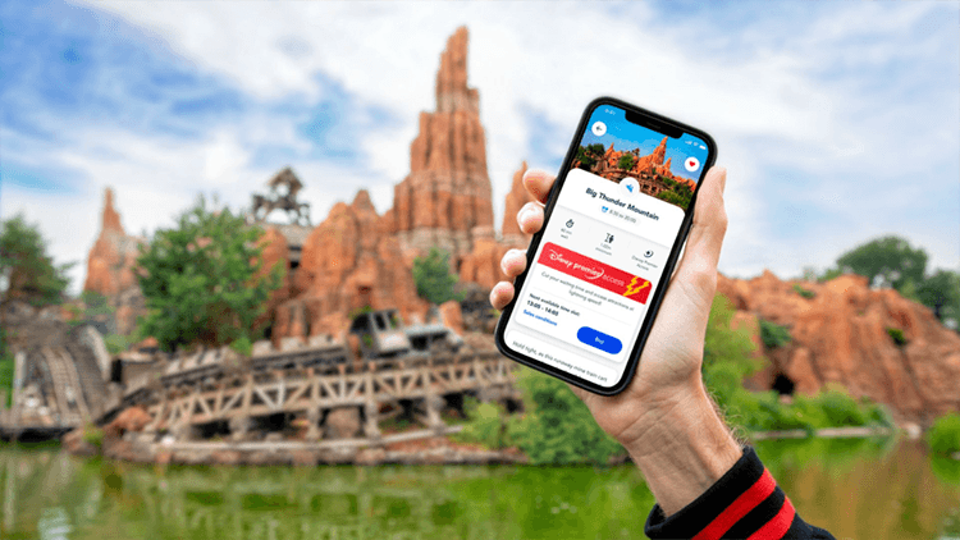
Is it any surprise that when Shanghai Disneyland reopened in June 2020, it was without free, paper FastPass, but with its upcharge Premier Access still available?
Disneyland Paris re-opened without FastPass, too, but it wasn’t until July 2021 that the park announced the official end of free FastPass at the French resort. The French resort’s replacement was also called Premier Access, but it was made up exclusively of a la carte, one-off line-skips with prices ranging from €8 to €15 per person per ride without the “bundles” formerly offered.
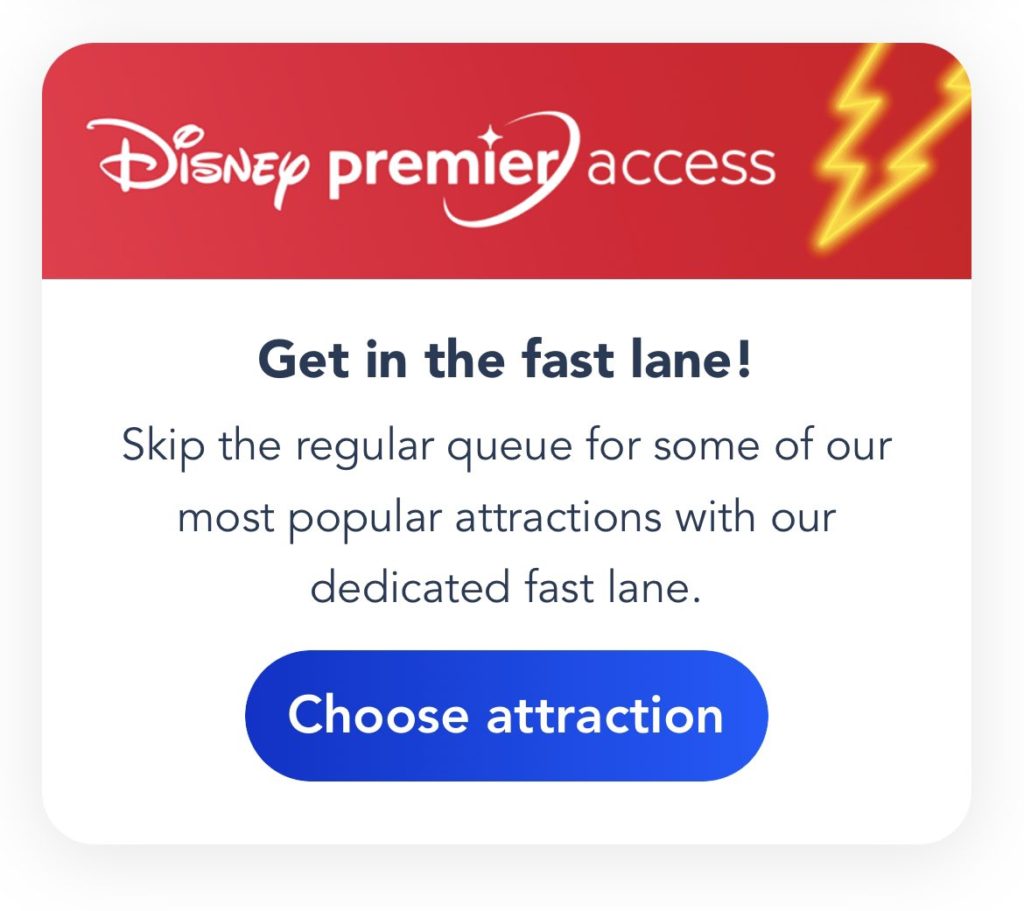
Want to join the “Premier Access” lane at Buzz Lightyear Laser Blast? All it takes is a $17 per person purchase in the app – about $70 for a family of four to skip one line, once! To Paris’ credit, the very, very high pricing would have at least kept utilization low, meaning “Stand-by” lines in Paris might return to the fast-moving queues they were before FastPass gunked them up!
(After about a year of individual Premier Access purchases, in 2022, Disneyland announced that they would re-re-invent the wheel by offering Premier Access Ultimate – a €90, once-per-ride anytime access bundle equivalent to the similarly-priced, pre-COVID ULTIMATE FastPass package. For $100, it’s a premium purchase to be sure. However, it’s both a smarter bet than paying $10 to $17 per ride, and a good fit for the French park where single-day visits are the norm more than multi-day.)
With both Shanghai and Paris using the pandemic as opportunities to officially cut their “free” line-skipping services – but retaining and expanding paid versions – it was a foregone conclusion that whatever happened in Florida and California, FastPass was exceedingly unlikely to return for free. And given the massive PR catastrophe that would’ve emerged from Disney’s famously-free FastPass returning for a price, that meant that the name “FastPass” was unlikely to return at all.
More than likely, Premier Access would be the model going forward. It seemed inevitable that Disneyland and Walt Disney World would soon introduce their own extravagantly-priced, individual access, a la carte line-skipping systems. But the “Waiting Game” is full of surprises, including what came next…
Disney Genie+
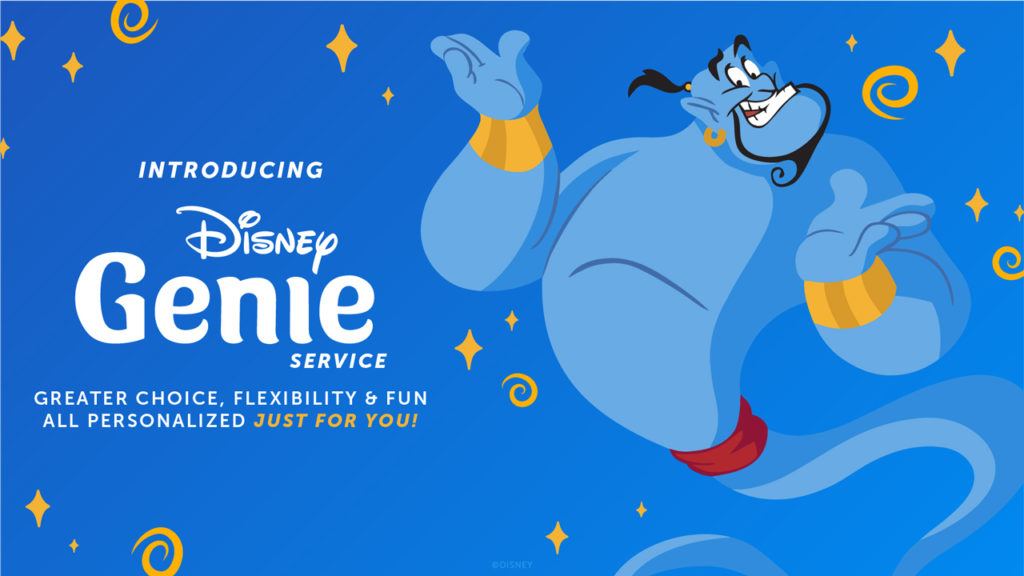
At the semi-annual D23 Expo in 2019 – long before the pandemic – Disney had already announced the development of Disney Genie, a complimentary trip-planning software no doubt meant to ease the pre-scheduling burden created by MyMagic+ in the 2010s. At that time, Disney Genie was expected by many to be an app that would smartly design itineraries for guests, essentially “automating” the increasingly-exhausting pre-planning required to enjoy an Orlando trip.
Doubtlessly, Disney Genie would do some things (like itinerary building and schedule recommendations) for free, but do a whole lot more (like auto-snatching FastPasses and Dining Reservations without 7 AM wake-ups) for a price. Of course, post-COVID-closures, all of those logistics went out the window, anyway. When the finalized details of Disney Genie came to light in fall 2021, the “service” and the Genie brand had been commandeered.
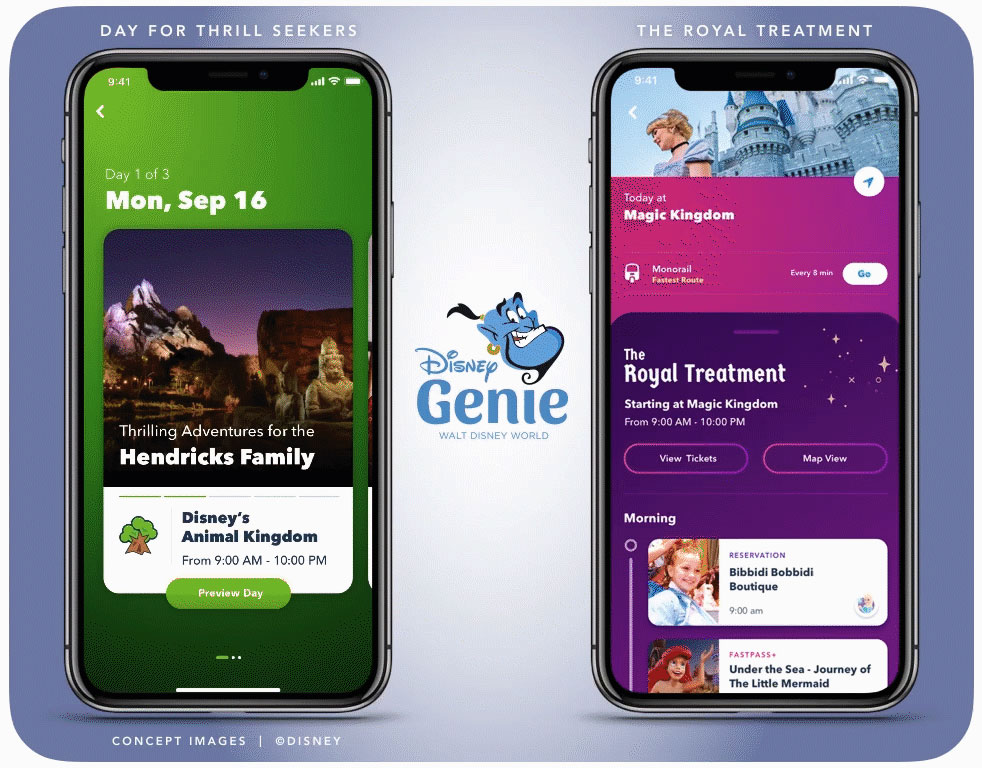
The free service – simply called Disney Genie – was indeed an itinerary builder. Genie would zooms into each day of a visit, coordinating your admission media and “Park Pass” reservation, then asking for broad suggestions of Disney brands or ride types you enjoy, height requirements, accessibility considerations, “must-see” rides, and hoped-for dining.
In practice, it was almost hilariously inept. Furious would be the first-timer who actually adhered to Genie’s “smart” schedule, which very clearly prioritizes guest distribution over enjoyment (meaning those who follow it will be directed to spend the precious “rope drop” hour wasting time at rides that remain walk-ons all day), recommends restaurants whose reservations sold out months ago, and makes approximately zero attempt to get guests onto the rides they tell the app they’re most excited for.
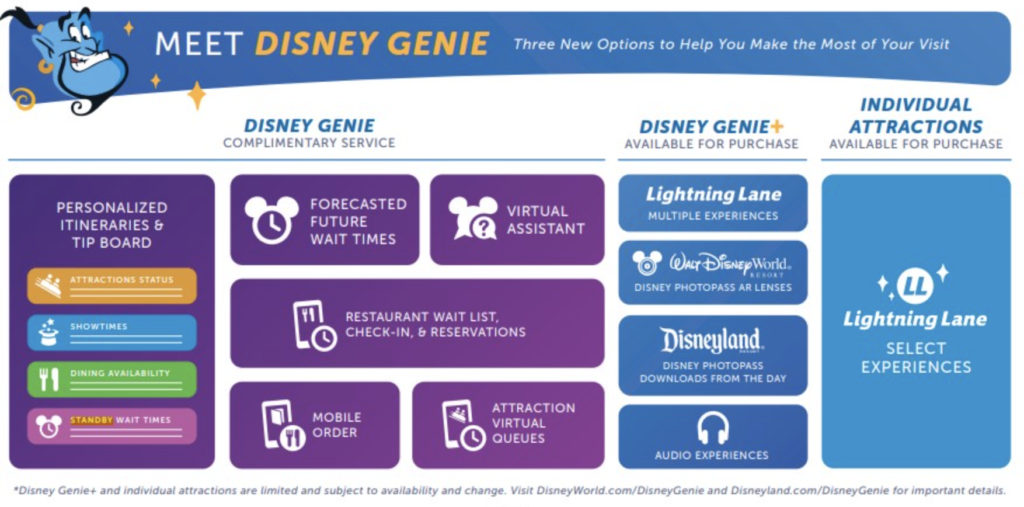
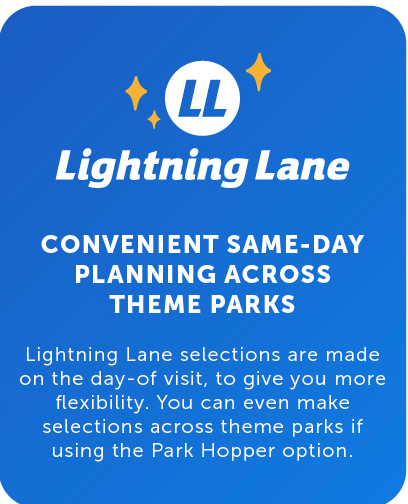
Unsurprisingly, the most frequent recommendation in Genie’s plans is that you should upgrade to the paid half of the service – Disney Genie+ (read, “Disney Genie Plus”; initially, $15 per person per day at Disney World, $20 per person per day at Disneyland). Though it had some accessory features, there was no question that Genie+’s selling point was that it granted one-at-a-time, day-of, rolling reservation access to priority-boarding “Lightning Lanes” at most attractions that used to offer FastPass+.
At Walt Disney World – where 60-day-out FastPass+ had been the norm for a decade – that meant that Genie+ returned a little spontaneity by allowing guests to book into return time slots one-at-a-time throughout the day – the much-missed way they last had with legacy, paper FastPass in the early 2000s, just via the app. If that sounds like something closer to the FastPass of yore (or more accurately, almost exactly like Disneyland’s MaxPass), you’re right… on paper.
But as usual, the arcane, complex machinations of Disney World’s operations boastfully added unfathomable frustration.
Frustrations & frenzy

For example, Genie+ Lightning Lanes became available for booking each morning at 7:00:00 AM, and the “hottest” selection at each park often had its full day of Lightning Lane availability “sold out” before 7:01. In other words, if you intended to secure a park’s most in-demand Lightning Lane, you might have mere seconds – or less – to do it. That would mean a 6:55 wake-up each morning, eyes glued to the second hand on a clock to breathlessly refresh the very nanosecond the clock struck 7 AM.
That issue was worsened by Disney World’s parks’ low ride counts. At Animal Kingdom, for example, just four rides – Dinosaur, Na’vi River Journey, Kilimanjaro Safaris, and Kali River Rapids – initially offered Genie+ Lightning Lanes. If you were even a few minutes after 7:00 in getting into the app, an error occurred during “checkout,” or (worse) you just don’t know that Na’vi River Journey is the “obvious” best choice – then you may miss getting a Lightning Lane for it at all, meaning your $15 purchase has immediately lost tremendous value and you’ll be waiting at least an hour to get on the ride.
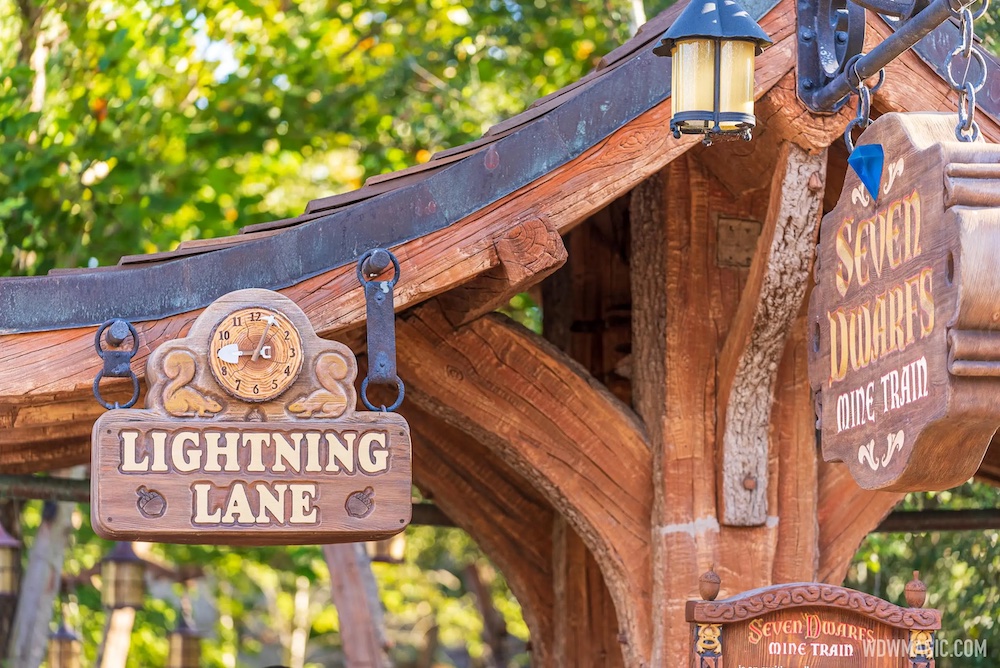
And that’s not all! Compounding the limited capacity available for Genie+, at each park, the one or two most sought-after attractions had Lightning Lanes, but they could not be booked into using the Genie+ service at all! Instead, a rotating list of high-demand attractions had former-FastPass queues that could only be accessed by confoundingly named Individual Lightning Lane purchases – initially, $7 to $20 per person, a la carte, once-per-ride line-skipping reservations.
For example, at Disney’s Animal Kingdom, your $15 per person purchase (that’s $60 for a family of four) immediately excluded the opportunity to access the Lightning Lanes for Expedition Everest or Avatar Flight of Passage – each of which would require its own a la carte purchase through the app. (“Individual Lightning Lane” attractions at Magic Kingdom were Seven Dwarfs Mine Train and Space Mountain; at EPCOT, Remy’s Ratatouille Adventure and Frozen Ever After; and at Hollywood Studios, Star Wars: Rise of the Resistance and Mickey & Minnie’s Runaway Railway.)
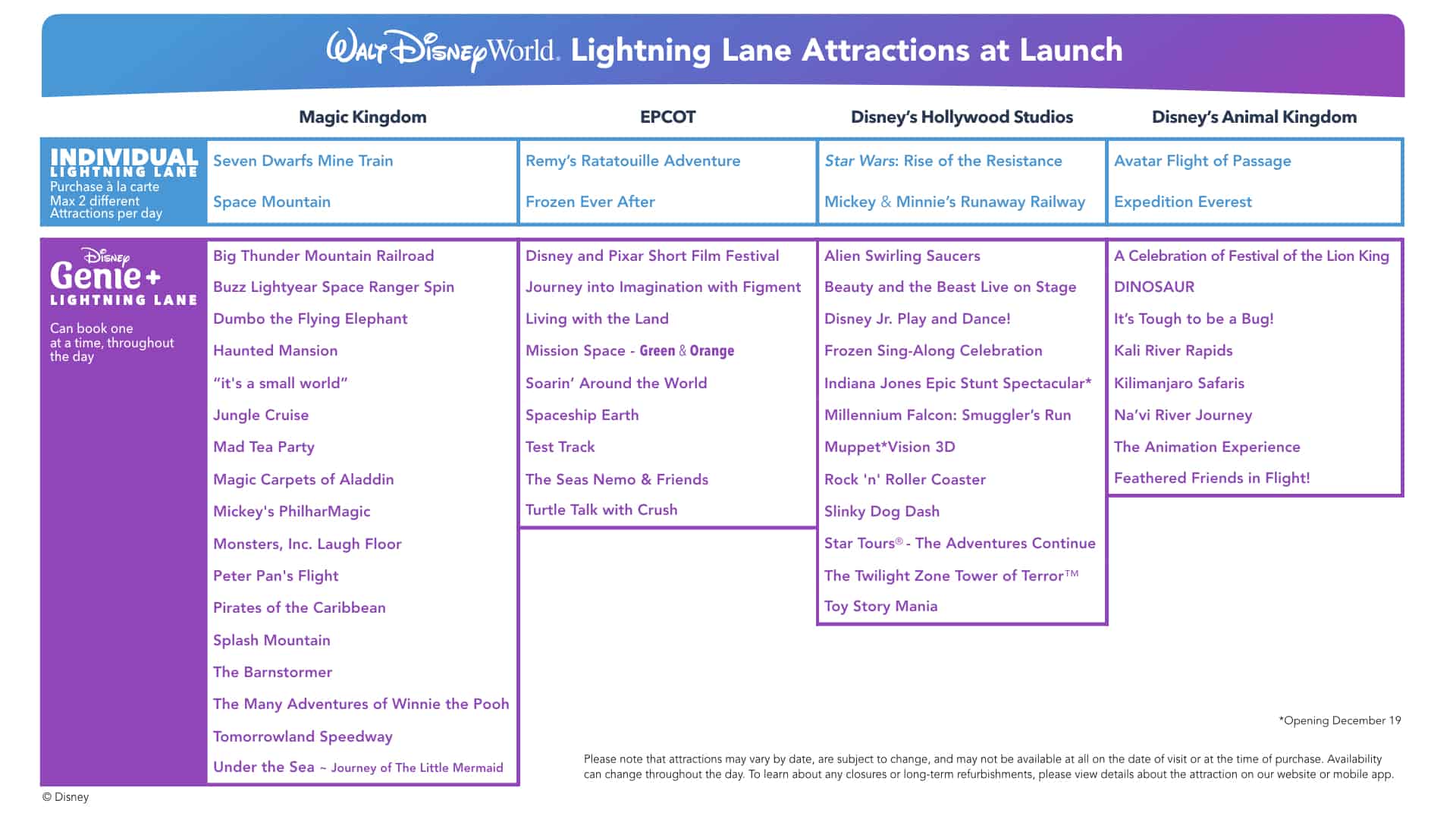
In other words, Walt Disney World’s Genie+ did add more spontaneity, choice, and day-of flexibility to the resort’s priority access system… But even if its added cost was relatively minor, it was also relatively limited in capacity, frustrating to use, easy to get “wrong,” limited in its usefulness, and automatically omitted the two most popular rides, which became their own, separate nickel-and-dime upcharge. (Never mind that the best term that Disney – an globally-renowned international media conglomerate – could come up with is “Individual Lightning Lane.”)
Laughably complex and wildly frustrating, Genie+ made roundabout zero fans. Even casual day-guests – millions of whom have yet to return to the parks post-pandemic to find the trusty, free FastPass transformed into such a purposefully convoluted upcharge ruled by statutes that could only be learned by reading exhaustive best-practice park guides with nickel-and-dime add-ons, 7 AM wake-ups, and reduced capacity – reliably reported dissatisfaction with the service.
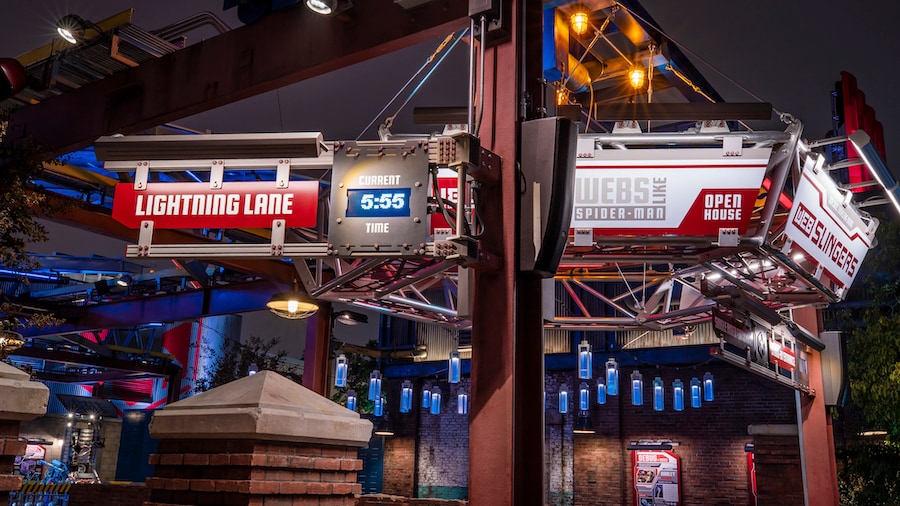
For a while, it seemed like a matter of time before Disney played it off as if they’d always intended Genie+ to be a special, limited-time offering, just for the 18-month 50th Anniversary Celebration at Walt Disney World. Shrugging it off as if it were always the plan, perhaps they’ll insist that Genie+ was merely a middle-man; a low-cost way to wean guests off of FastPass for good.
But let’s face it: the Genie+ era assured us that there will never again be a day when you can join the priority access queue of Flight of Passage or Rise of the Resistance without paying for it. The only question was how. Would the separate Genie+ and Individual Lightning Lane systems stick around? Would it be replaced by an all-a-la-carte, individual, $15 per ride system like Premier Access? A $250-a-day, once-per-ride add-on like Universal Express? Maybe reinventing the wheel by offering 60-day-out FastPass+ but charging $20 for it?
The changes began quickly… and culminated in the Genie being put back in the bottle entirely. But don’t get too excited… Read on!



What really bothered me during my sole post-fastpass trip relates to this idea that “Unfair waits are longer than equitable waits.“
If a ride goes down due to weather or maintenance, when it comes back up they prioritize the Lighting Lane and drastically increase the ratio of Lightning Lane to stand-by guests.
During my trip I had not purchased Genie+, so it was horrible waiting in the excruciatingly slow stand-by after a ride name back up. When FastPass was complimentary to everyone, this same scenario didn’t bother me, as I would also benefit from the operational change when my FastPass return time came, however, in this new system, these ‘higher-tiered’ guests were prioritized making the wait feel particularly inequitable and ergo felt way longer.
My biggest takeaway from this is how short Expedition Everest’s line was in 2015. Less than 30 minutes? Sign me up! I am glad others agree about the issues with Fastpass and I now have a place to link them to on why.
I think your solution is an interesting one. I agree that fastpasses should be cut down to larger attractions but I have never heard the idea of not opening it until the standby hits a certain time quota.
I think we could see some interesting queue changes in the future here!